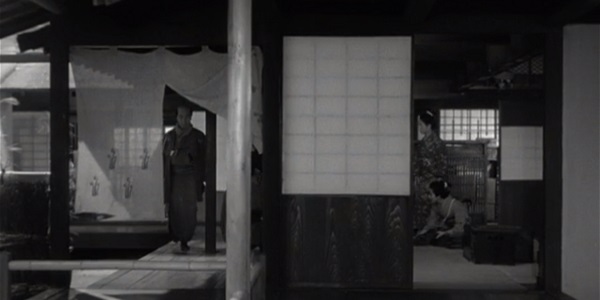A Story from Chikamatsu, also known as The Crucified Lovers, is one of two films released in 1954 from director Kenji Mizoguchi. The other one is the more well-known Sansho the Bailiff, a film many viewers find to be an intensely emotional experience. A Story from Chikamatsu is also an emotional film, but quite different in focus: while Sansho the Bailiff is a film about metaphysical principles, A Story from Chikamatsu is about nothing but its own setting. It takes place in 18th century Japan, and it unfolds from the social phenomenon its second title refers to: the crucifixion of adulterers, and the conventions and balances of power associated with it.
It begins at the household of a wealthy and influential scroll maker. The madam of the household, Osan (Kyôko Kagawa), needs money to save her mother’s household, the Gifu-ya, from financial ruin. Otama (Yôko Minamida), a young maid of the household, has to lie in order to rebuff the master Ishun’s (Eitarô Shindô) advances. Both of them turn to Mohei (Kazuo Hasegawa), Ishun’s kindhearted apprentice, for help. I won’t reveal any more of the plot, since it unfolds from these circumstances in unpredictable ways, and one of the film’s strengths is that it shows the extent to which different problems can complicate each other.
Influence and Location
The film does not place us within any character’s perspective. The camera sees into multiple rooms at the same time. It’s often positioned at a distance from the characters, though mostly incidentally: they may move toward or away from it. Its distance is not a matter of being purposefully impersonal, as one might see in Kubrick, but as a matter of working with three dimensional space. The expressions of individual characters are only rarely emphasized. It’s observational, quasi-omniscient. The same goes for the way the film proceeds: we see the various characters’ stories in parallel with each other.

We see how minds change with changes in location, and how this can gives rise to problems that stretch across space and time. The rules and strata of Ishun’s household worm their way into Mohei’s sense of morality – until he’s somewhere outside Ishun’s household. Moreover, the effect of location on mind begins to mess with our heads when Ishun’s influence stretches beyond where it seems like it should belong. At the same time, Osan’s ties to the Gifu-ya family remain constant wherever she goes; but this means that changes in one place can have consequences for her or for them someplace remote.
Over all of this hangs the spectacle of crucifixion. Early in the film, we see an unnamed couple marched through the streets to their execution for adultery, and shortly afterward see a brief shot of their contorted bodies strung up on crosses. One of the most salient questions the film raises is this: who is served by this public humiliation and brutality? It seems to hang over the heads of all the characters, even Ishun and his associates in the nobility.
Love Unadorned
This uneasy feeling plays a major role in A Story from Chikamatsu‘s modest depiction of love. The lovers in this film don’t come across as soulmates, nor as especially heroic, nor do we even expect their romance. They’re just survivors, before anything else. Their love emerges from their ability to think beyond their repressive surroundings and the simple fact that they take action to pursue lines of flight. They’re fallible, undecorated people who nevertheless manage each to be what the other needs. From this arises something unique which neither of them could have built on their own.
We absorb this, like everything else, through the film’s restrained, observational style, all while many other parts of the film demand our attention. Thus, some viewers may not find the romance in A Story from Chikamatsu as moving as that in more private films like In the Mood for Love or romantic melodramas like A Matter of Life and Death. But when we arrive at the end of the film and see how deep this love goes and what it can do for a person, it’s hard not to feel we’ve just seen something important.
A Story From Chikamatsu: A Master’s Style
The upcoming Criterion Collection release of A Story from Chikamatsu includes a new restoration of the film, which is welcome since some scenes in the film are very dark and hinge on small details. The new release will also include two new pieces of commentary on Mizoguchi‘s work, a documentary and an essay, which should be illuminating. There’s a lot more ground one could cover regarding this film and Mizoguchi‘s films in general than I have been able to here.
What’s more, this film may be a better starting point than other films by Mizoguchi for those who haven’t encountered him before. It’s both less mystical than the more frequently canonized Sansho the Bailiff and Ugetsu, and more high-concept than films like The Story of the Last Chrysanthemums. Of course, it’s just as rich as any of those films.
A Story from Chikamatsu will be available on Blu-ray from the Criterion Collection on November 6, 2018.
Does content like this matter to you?
Become a Member and support film journalism. Unlock access to all of Film Inquiry`s great articles. Join a community of like-minded readers who are passionate about cinema - get access to our private members Network, give back to independent filmmakers, and more.